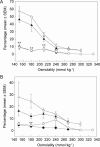Maturation of sperm volume regulation in the rat epididymis
- PMID: 20531277
- PMCID: PMC3739377
- DOI: 10.1038/aja.2010.50
Maturation of sperm volume regulation in the rat epididymis
Abstract
Sperm maturation in the epididymis may involve differences between mature and immature spermatozoa in their volume regulatory osmolyte response. Spermatozoa obtained from the rat caput and cauda epididymidis were examined for their ability to regulate volume after transfer from in situ epididymal osmolality (measured to be 343 +/- 13 and 365 +/- 19 mmol kg(-1), respectively) to that of the female tract in single- and multiple-step protocols. Cells withstood the single-step treatment better than the multistep protocol. Sperm volume estimates by flow cytometric measurements of forward scatter of cells with intact head membranes was more sensitive than those by assessing cell coiling microscopically. At osmolalites below 210 mmol kg(-1) both caput and cauda cells ruptured, limiting the use of flow cytometry. Above this critical value, the use of quinine showed that both caput and cauda cells could regulate volume, but cauda cells were the more effective. Of several organic osmolytes studied, myo-inositol, glutamate and KCl caused only temporary and slight swelling of spermatozoa cells in hypotonic medium. Spermatozoa of both maturities seemed to use potassium as the preferred osmolyte for regulating volume.
Figures








Similar articles
-
Effects of putative epididymal osmolytes on sperm volume regulation of fertile and infertile c-ros transgenic Mice.J Androl. 2004 Mar-Apr;25(2):216-23. doi: 10.1002/j.1939-4640.2004.tb02781.x. J Androl. 2004. PMID: 14760007
-
Effects of caput ligation on rat sperm and epididymis: protein thiols and fertilizing ability.Biol Reprod. 1992 Feb;46(2):301-8. doi: 10.1095/biolreprod46.2.301. Biol Reprod. 1992. PMID: 1536907
-
Control of bull sperm cell volume during epididymal maturation.Reprod Fertil Dev. 2009;21(3):469-78. doi: 10.1071/rd08162. Reprod Fertil Dev. 2009. PMID: 19261224
-
Acquisition of volume regulatory response of sperm upon maturation in the epididymis and the role of the cytoplasmic droplet.Microsc Res Tech. 2003 May 1;61(1):28-38. doi: 10.1002/jemt.10314. Microsc Res Tech. 2003. PMID: 12672120 Review.
-
Sperm maturation in the epididymis: a new look at an old problem.Asian J Androl. 2007 Jul;9(4):533-9. doi: 10.1111/j.1745-7262.2007.00285.x. Asian J Androl. 2007. PMID: 17589792 Review.
Cited by
-
Testicular and epididymal toxicity induced by benzo(a)pyrene, alcohol, and their combination in Wistar rats.Toxicol Res (Camb). 2015 Nov 25;5(2):420-433. doi: 10.1039/c5tx00420a. eCollection 2016 Mar 1. Toxicol Res (Camb). 2015. PMID: 30090357 Free PMC article.
-
Epididymal research: more warp than weft?Asian J Androl. 2015 Sep-Oct;17(5):699-703. doi: 10.4103/1008-682X.146102. Asian J Androl. 2015. PMID: 25652625 Free PMC article.
-
The epididymis, cytoplasmic droplets and male fertility.Asian J Androl. 2011 Jan;13(1):130-8. doi: 10.1038/aja.2010.97. Epub 2010 Nov 15. Asian J Androl. 2011. PMID: 21076437 Free PMC article. Review.
-
Cysteine dioxygenase is essential for mouse sperm osmoadaptation and male fertility.FEBS J. 2018 May;285(10):1827-1839. doi: 10.1111/febs.14449. Epub 2018 Apr 16. FEBS J. 2018. PMID: 29604178 Free PMC article.
-
Direct but no transgenerational effects of decitabine and vorinostat on male fertility.PLoS One. 2015 Feb 18;10(2):e0117839. doi: 10.1371/journal.pone.0117839. eCollection 2015. PLoS One. 2015. PMID: 25692788 Free PMC article.
References
-
- Dyson AL, Orgebin-Crist MC. Effect of hypophysectomy, castration and androgen replacement upon the fertilizing ability of rat epididymal spermatozoa. Endocrinology. 1973;93:391–402. - PubMed
-
- Paz (Frenkel) G, Kaplan R, Yedwab G, Homonnai ZT, Kraicer PF. The effect of caffeine on rat epididymal spermatozoa: motility, metabolism and fertilizing capacity. Int J Androl. 1978. pp. 145–52.
-
- Blandau RJ. On the factors involved in sperm transport through the cervix uteri of the albino rat. Am J Anat. 1945;77:253–72.
-
- Rossman I. Uterine contractions and the transport of sperm of the rat. Anat Rec. 1937;69:133–49.
-
- Blandau RJ, Rumery RE. The relationship of swimming movements of epididymal spermatozoa to their fertilizing capacity. Fertil Steril. 1964;15:571–9. - PubMed
Publication types
MeSH terms
Substances
LinkOut - more resources
Full Text Sources

